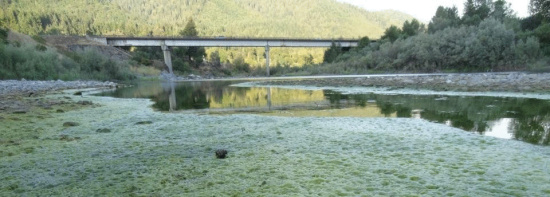Photo of Trinity River taken this year. Courtesy Hoopa Valley Tribe, in a different context.
PREVIOUSLY
- ‘Fish Need Water! Let the River Flow!’: Tribal Members Protest in Sacramento (VIDEO/PHOTOS)
- Avoid Contact With Algae, Department of Health and Human Services Warns
###
From the Humboldt County Department of Health and Human Services:
Officials from the Humboldt County Department of Health and Human Services (DHHS) report that toxins associated with blue-green algae have been detected in the Trinity River. Health advisory signs are being posted, and confirmation testing is currently under way.
Low flows along several other local rivers including the South Fork Eel, Van Duzen and Mad Rivers, coupled with sustained high temperatures in the inland areas and record low rainfall have created the ideal conditions for blue-green algae.
Blue-green algae can be present in any fresh water body. It looks like green, blue-green, white or brown scum, foam or mats floating on the water. Usually it does not affect animals or people. However, warm water and abundant nutrients can cause blue-green algae to grow more rapidly than usual. These floating algal masses or “blooms” can produce natural toxins that are very potent. Dogs and children are most likely to be affected because of their smaller body size and tendency to stay in the water for longer periods.
DHHS is aware of 11 dog deaths which may have been caused by blue-green algae poisoning since 2001. The dogs died shortly after swimming in Big Lagoon, the South Fork Eel River and the Van Duzen River. Last year there was a reported dog illness that was suspected to be caused by toxic algae on the Mad River near Blue Lake, but this was not confirmed by water samples.
Most algal blooms in California contain harmless green algae. While the presence of blue-green algae toxins have been confirmed in some instances on the South Fork Eel and Van Duzen Rivers, it is difficult to test and monitor the many miles of our local rivers with conditions that may readily change. Most blooms do not contain toxins. To stay safe, it is best to assume that an algal bloom has the potential to contain toxins.
Blue-green algae blooms that produce a liver toxin have been documented in Klamath River reservoirs and the Klamath River this year. Current status of this river may be found at the Klamath Basin Monitoring Program website: http://www.kbmp.net/maps-data/blue-green-algae-tracker.
Potential symptoms in dogs following exposure to blue-green algae toxins can include lethargy, difficulty breathing, salivation, vomiting, urination, diarrhea, or convulsions. People can experience eye irritation, skin rash, mouth ulcers, vomiting, diarrhea, and cold or flu-like symptoms. While there is no antidote for exposures, persons should see their physician and those with pets which may have been exposed should go to their veterinarian for supportive care.
DHHS officials recommend the following guidelines for recreational users of all freshwater areas in Humboldt County:
- Keep children, pets and livestock from swimming in or drinking water containing algal scums or mats.
- Adults should also avoid wading and swimming in water containing algal blooms. Try not to swallow or inhale water spray in an algal bloom area.
- If no algal scums or mats are visible, you should still carefully watch young children and warn them not to swallow any water.
- Fish should be consumed only after removing the guts and liver and rinsing fillets in tap water.
- Never drink, cook with or wash dishes with water from rivers, streams or lakes.
- Get medical attention immediately if you think that you, your pet, or livestock might have been poisoned by blue-green algae toxins. Be sure to tell the doctor about possible contact with blue-green algae.
Human activities can have a big effect on nutrient and water flows in rivers, streams or lakes. Phosphorous and nitrogen found in fertilizers, animal waste, and human waste can stimulate blooms. Excessive water diversions can increase water temperatures and reduce flows. People can take the following measures to prevent algal blooms in our waters:
- Be very conservative with the use of water, fertilizers and pesticides on your lawn, garden or agricultural operation.
- Recycle any “spent” soil that has been used for intensive growing by tilling it back into gardens. Or protect it from rainfall to avoid nutrient runoff.
- Plant or maintain native plants around banks. These plants help filter water and don’t require fertilizers.
- Pump and maintain your septic system every three to four years.
- Prevent surface water runoff from agricultural and livestock areas.
- Prevent erosion around construction and logging operations.
- Join or support one of the many watershed and river organizations.
Contact the Humboldt County DHHS Division of Environmental Health at 445-6215 or 1-800-963-9241 for more information. People may report unusual blooms or conditions, including pictures, to Environmental Health by emailing envhealth@co.humboldt.ca.us. For more details, visit the California Department of Public Health’s website: www.cdph.ca.gov/healthinfo/environhealth/water/Pages/bluegreenalgae.aspx.

CLICK TO MANAGE